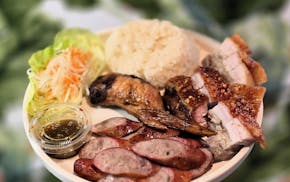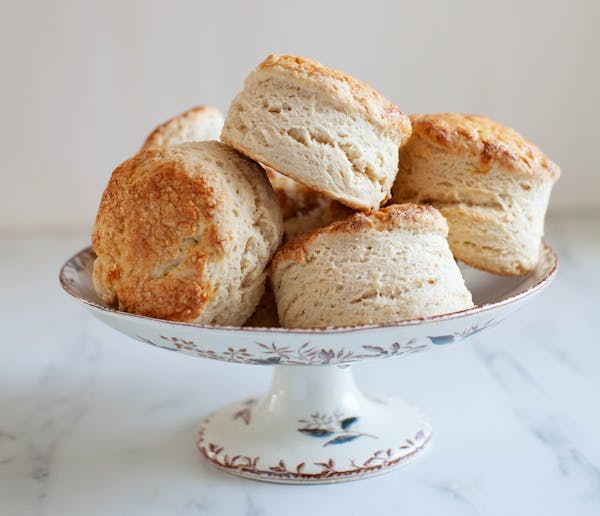"A cake can turn any Tuesday into an occasion," writes Zoë François in the just-released "Zoë Bakes Cakes" (Ten Speed Press, $30). "Cake is the way I tell my friends and family that I love them."
The tireless author became a force in the cookbook world by co-writing the wildly successful "Artisan Bread in Five Minutes a Day" series with fellow Minnesotan Jeff Hertzberg.
With "Zoë Bakes Cakes," François is turning to a different side of her passion for baking, sharing dozens of cake recipes, from family favorites to re-creations of discoveries she's encountered during her travels. But before delivering the goods, François starts with a series of easy-to-absorb tutorials — she calls it the Cake Academy — that are culled from her vast pastry chef's know-how.
François has been busy. Along with producing "Zoë Bakes Cakes" (after formulating the recipes in her well-equipped Minneapolis kitchen, she also shot many of the book's hunger-inducing photographs) and keeping her 300,000 Instagram followers engaged (find her @zoebakes), she's also starring in a television series, "Zoë Bakes," for the new Magnolia Network (watch the first episode now on Discovery Plus).
In a recent phone conversation, François discussed the beauty of Minnesota-made Bundt pans, the power of Instagram and the joys of cake stands.
Q: After eight bread books, why a cake book?
A: This book is really intimate to me, because it's all my stories, it's all of the things that I love. My goal is to teach techniques, and to give just enough food science to understand what went wrong. It's about giving people the confidence to bake. I want the book to exude the love and the joy that I get out of this process. Not that we didn't do that with the bread books, but this felt personal to me.
Q: How does a cake earn the Zoë François seal of approval?
A: There are certain things with cakes that are true with savory cooking. You want a balance of flavors, you want sweet and bitter, or sour. Sweets can be too sweet, that's the only note that doesn't necessarily do it for me. That's what I love about coffee in devil's food chocolate cake. The cake doesn't taste like coffee, but the bitterness of the coffee is a balance to the sweet, and you need that to get a complete picture of the cake. For that reason, salt plays a huge part in baking: It perks up all the flavors.
Q: The book includes the toffee-date cake that you created for Tilia, chef Steven Brown's Linden Hills restaurant. What's the origin of that recipe?
A: It was really Steven's idea, it wasn't something in my normal rep. I love dates, because they're sweet and rich, and they add this incredible texture to a cake. Caramel is one of those things for me, it shows up a lot in the book. People think of caramel as purely sweet, but it can have this bitter edge to it that adds a nice dimension to a cake.
Q: The book is divided into styles of cakes — layered, soaked, Bundt and more. Do you have a favorite style?
A: I love anything that's soaked. Pouring caramel, or juice, or simple syrup or some other flavored something into a cake is a style that really does it for me. It's a style that's popular everywhere else in the world but here. But I have to say that my other true love is meringue-based cakes. I love the texture of them. I love how light they are, especially when you're having dessert after a big meal. And working with meringue is fun. You can cover a cake with it and light it on fire with a blowtorch.
Q: One of the book's many helpful pointers is your foolproof approach to whipped cream. Where did you pick up that method?
A: It's something I learned in culinary school, although not necessarily for whipped cream, maybe it was for génoise. People always overwhip their cream, and it gets greasy or it doesn't fold into things beautifully. Whip it low, and slow. That creates tiny air bubbles that don't pop, and you get a whipped cream that's super-stable, and really luscious. I have it going until I can see the whip attachment is making tracks in it, what some people might call medium peak. Then I finish it by hand, for about 20 seconds. That's what makes perfect whipped cream.
Q: When baking cakes, you advocate the spoon-and-sweep method for measuring flour, where flour is spooned into the measuring cup, rather than scooping the measuring cup directly into the flour. Why?
A: Spoon-and-sweep is the King Arthur flour method, and it's used because then the flour is more aerated. When I was traveling I saw that when people were baking with King Arthur flour and used the scoop-and-sweep method, they ended up with a drier cake. But this is the hardest thing that I had with the book. Everyone measures their flour differently. I weigh everything. I wish everyone measured by weight, then we wouldn't have to worry about these things.
Q: Are you saying that all bakers should buy a kitchen scale?
A: Yes. It's so much easier to deal with, and it's way more consistent. You get the same weight, every time.
Q: Do you bake with Bundt pans out of obligation, because you're a Minnesotan? Or because you love them?
A: Bundt pans are such a gift to a baker. They're like a stand mixer, they do all the work for you. All you need is a dusting of confectioner's sugar, and you're done. You've got a cake that's worthy of a dinner party, and it's all because of that pan.
Q: What role has Instagram played in your work?
A: It has changed everything. The blog [zoebakes.com] is more about communicating out into the world. It's not so much a dialogue, it's not so much about people sharing with us and us sharing with them. Then I discovered Instagram Stories. With baking, people are super-intimidated, they need to see tricks and tips visually. I started making videos, and it was instant feedback. When COVID hit, I started doing Instagram Live, and that's how people found me, and we became a community. It opened up a lot of opportunities for me. I've met a lot of people and established friendships because of it, and it has had a profound effect on me and on my career. It's my portfolio. Some people have résumés, I have Instagram Live.
Q: How many cake stands are in your collection?
A: There can never be enough. Marie Dwyer of Cooks of Crocus Hill had gone to Martha Stewart's studio, and she sent me a picture of the prop room. Martha must have 500 cake stands. Not that you don't envy everything that woman has, but my god, that's a life goal. Let's just say I have more than most, but less than Martha, and we'll leave it at that.
Sticky Toffee-Date Cake
Makes 12 individual cakes.
Note: "When my friend Steven Brown asked me to design a dessert program for his now-famous Tilia restaurant, he had two requests: There had to be a butterscotch pudding and a sticky toffee-date cake," writes Zoë François in "Zoë Bakes Cakes" (Ten Speed Press). "I bake them in individual servings so they can be tipped out and topped with a scoop of ice cream (I use rum raisin), like a crown."
For the cake:
• 12 oz. Medjool dates (about 12 to 14 large dates)
• 1 tsp. baking soda
• 1 tsp. freshly grated ginger
• 6 tbsp. (3/4 stick) unsalted butter, at room temperature, plus extra for ramekins or muffin tins
• 1 c. (200 grams) lightly packed brown sugar
• 2 tsp. vanilla extract
• 2 eggs, at room temperature
• 2 tbsp. rum
• 2 c. (240 grams) flour
• 1 tbsp. baking powder
• 1/2 tsp. kosher salt
For the toffee sauce:
• 1/2 c. heavy whipping cream
• 1 c. (200 grams) lightly packed brown sugar
• 2 tbsp. rum
• 2 tbsp. unsalted butter
• 1/2 tsp. kosher salt
• Ice cream, for serving (see Note)
Directions
To prepare cake: Preheat oven to 325 degrees. Generously butter 12 (6-ounce) ramekins — or 12 muffin tins — and set on a baking sheet.
Remove pits from the dates and discard pits. In a medium saucepan over medium heat, combine the dates and 1 cup plus 2 tablespoons water. Cover pan and simmer for about 5 minutes to soften dates. Remove from heat and let sit, covered, for another 5 minutes until dates are tender; it may take up to an additional 5 minutes if dates are dried out.
Transfer dates and water to a blender and purée until smooth. Return the purée to the pan, return the pan to medium heat and cook, stirring, until the purée begins to sizzle, about 1 minute. Remove pan from the heat and stir in the baking soda and ginger; the mixture will foam and darken. (The baking soda neutralizes the acid in the dates and creates a rich dark color.) Let purée cool slightly.
In the bowl of an electric mixer on medium-high speed, beat 6 tablespoons butter until creamy and smooth, about 1 minute. Reduce speed to medium, add 1 cup brown sugar and vanilla extract and beat until the mixture is light in color and about double in volume, about 5 minutes. Reduce speed to medium-low and add the eggs, one at a time, beating until just combined and scraping the bowl after each addition. Add 2 tablespoons rum and mix until evenly incorporated.
In a medium bowl, whisk together the flour, baking powder and 1/2 teaspoon kosher salt.
With the mixer on low speed, add one-third of the flour mixture to the butter mixture, mixing until just combined. Add half of the date purée and mix to incorporate. Repeat with another one-third flour, the remaining date purée, and then finish with the final one-third flour, scraping the bowl after each addition. Mix only enough to combine.
Evenly scrape the batter into the prepared ramekins (or muffin tins). Bake until the cakes are golden and a tester comes out with moist crumbs, about 30 minutes. Don't overbake; you want them to be slightly puddinglike, but the tester shouldn't be wet.
To prepare toffee sauce: While the cakes are baking, in a small saucepan over medium-high heat, combine the cream, 1 cup brown sugar, 2 tablespoons rum, 2 tablespoons unsalted butter and 1/2 teaspoon kosher salt, and bring to a boil, stirring constantly. Reduce heat to medium-low and simmer until thicker, about 5 minutes. Remove from heat.
When the cakes come out of the oven, using a skewer, poke holes every 1/2 inch, through to the bottoms, and spoon two-thirds of the sauce over the tops, dividing the sauce evenly between cakes. If the sauce doesn't get completely absorbed into the cake, poke a few more holes.
Let the cakes cool for 10 minutes, then invert onto individual plates and spoon the remaining sauce over the tops. Serve immediately with ice cream. If you don't use all the cakes at once, keep them in their ramekins (or muffin tins), tightly covered, and refrigerate for up to 24 hours. Microwave for several seconds before serving with remaining sauce.
Rick Nelson • @RickNelsonStrib

Critics' picks: The 11 best things to hear, do and see in the Twin Cities this week

Critics' picks: The 9 best things to do and see in the Twin Cities this week

The 5 best things our food writers ate this week

The 5 best things our food writers ate this week

